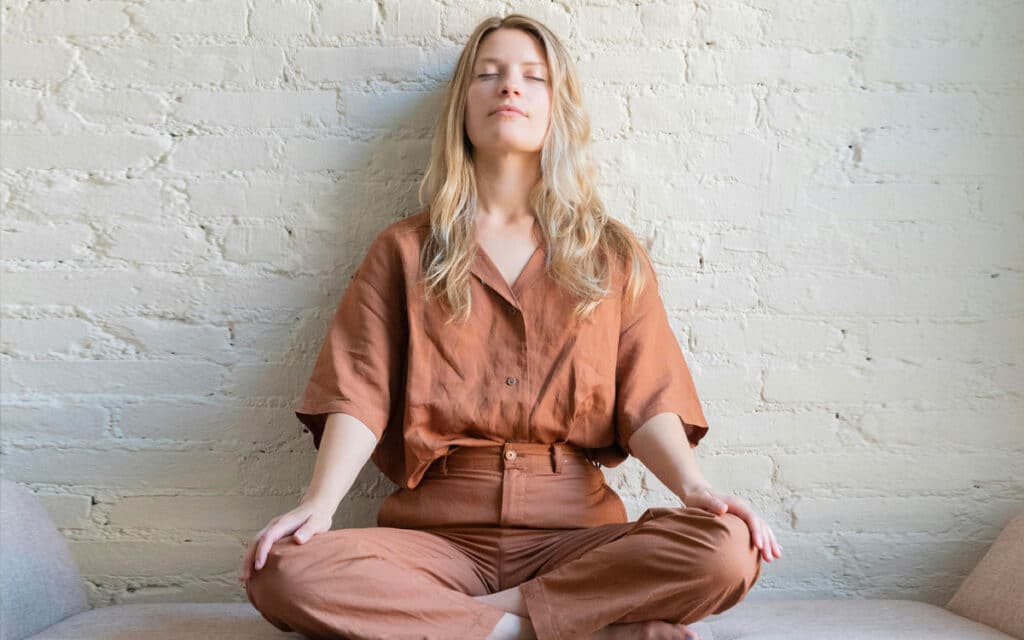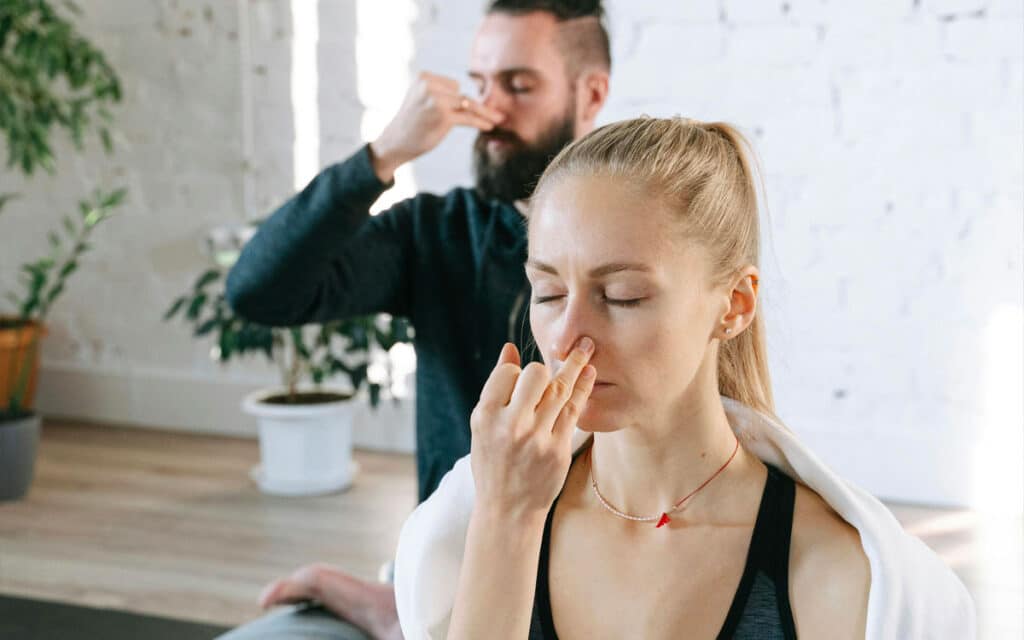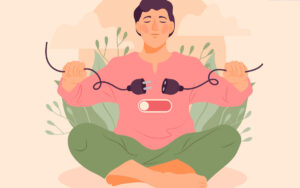In today’s fast-paced world, young adults often find themselves overwhelmed by a constant flood of thoughts, emotions, and external pressures.
The need to stay connected, perform well in school or at work, and manage personal relationships can lead to feelings of anxiety, stress, and even burnout.
Luckily, ancient practices like yogic breathwork offer a natural and accessible way to regain calm and control.
Key Benefits:
- Alleviates anxiety through breath regulation
- Promotes mental clarity and emotional resilience
- Strengthens the mind-body connection for overall well-being
- Provides tools to manage stressful situations proactively
Understanding Yogic Breathwork
Breathwork, or pranayama in yoga, is a fundamental practice that helps to control the flow of breath, which directly impacts the nervous system and emotions.
When faced with overwhelming situations, our natural response is often to breathe shallowly or irregularly.
Breathwork techniques, however, teach us how to reverse this, inviting calm into the body and mind.
Why Are Young Adults So Stressed?
Young adults face unique pressures that come from trying to balance school, work, social media, relationships, and future planning. Anxiety, whether it’s from performance expectations, social comparisons, or financial worries, can often manifest physically—through shallow breathing, a racing heart, and mental fog. It’s not uncommon to feel disconnected from the present moment and overwhelmed by the daily grind.
The good news is that the vagus nerve, a critical player in the body’s “rest and digest” response, can be activated to help counter these effects. Stimulating this nerve through breathwork sends signals to the brain to reduce stress, slow the heart rate, and ease tension.

1. Deep Belly Breathing (Diaphragmatic Breathing)
This practice helps slow the mind by focusing on deep, controlled breathing. It’s one of the simplest but most effective techniques to calm the body during anxiety.
How to Practice:
- Sit in a comfortable position.
- Place one hand on your belly and the other just above the solar plexus (the area below your chest).
- Close your eyes and take a deep breath through your nose, allowing your belly to expand and lift your hand while your chest remains still.
- Hold the breath for a moment.
- Slowly exhale through your mouth, feeling your belly contract as you press gently down.
- Repeat for 5–10 minutes, letting the gentle rhythm of your breath ground your attention and relax your body.
Essential Oil Addition: Basil Blend
To enhance the calming effects of deep belly breathing, you can add an essential oil blend to your practice. Basil essential oil is known for its anti-anxiety properties and can help release physical tension, especially in the lower back and spine, areas that often store stress.
- Recipe:
- 30ml of a carrier oil like coconut or sweet almond
- 5 drops of basil essential oil
Application: Gently massage a small amount of the blend onto your lower back and along the spine. The warmth from the massage and the soothing aroma of basil will help deepen your relaxation, allowing for a more effective breathing practice.

2. Oceanic Breath (Ujjayi Pranayama)
This soothing breathwork technique creates a gentle “ocean-like” sound, promoting relaxation and improving mental focus. It’s particularly helpful for those moments when anxiety clouds your thoughts and concentration feels difficult.
How to Practice:
- Sit comfortably, with your back straight. Breathe in deeply through your nose.
- As you exhale, gently constrict the back of your throat, creating a soft sound, similar to ocean waves.
- Repeat this breathing pattern slowly, focusing on the rhythmic sound, for 5 to 10 minutes.
Tip: Practicing this method before going to bed can help calm the nervous system, release tension from the day, and prepare the body for restful sleep.
Essential Oil Addition:
For a deeper relaxation effect, consider using this Bedtime Relaxation Oil Blend:
- Recipe:
- 30ml of jojoba oil
- 5 drops of marjoram essential oil (for its calming properties)
- 5 drops of lavender essential oil (for relaxation)
- 5 drops of petitgrain essential oil (for reducing stress)
Application: Apply a small amount of the oil blend to your chest and lower back before starting the breathwork. This combination of oils will help enhance the calming effects of the practice, making it even more effective for reducing anxiety and promoting deep, restful sleep.

3. Alternate Nostril Breathing (Nadi Shodhana)
This practice helps balance both hemispheres of the brain, improving concentration and creating a sense of inner calm.
How to Practice: Close your right nostril with your thumb and inhale deeply through the left nostril. Close your left nostril and exhale through the right. Continue alternating between nostrils for several rounds, focusing on the breath as it moves through your body.
Essential Oil Addition: Calming Oil Blend
For added mental focus and calm during alternate nostril breathing, apply a calming essential oil blend.
- Recipe:
- 30ml almond oil
- 5 drops chamomile essential oil
- 5 drops sandalwood essential oil
- 5 drops neroli essential oil
Application: Gently massage the blend onto your temples and wrists before starting your practice. The calming properties of these oils will help you stay present and focused.
Grounding Techniques for Anxiety
Grounding techniques help bring you back to the present moment, reducing racing thoughts and emotional overwhelm.
How to Practice: Sit or stand with your feet planted firmly on the ground. Focus on the physical sensation of your feet connecting with the earth. Slowly engage all five senses by noticing the details of your surroundings—what you can hear, see, touch, and smell. Doing this practice helps create a strong sense of stability and calm.
Essential Oil Addition: Grounding Oil Blend
For an added sense of balance, use a grounding essential oil blend during this practice.
- Recipe:
- 30ml of jojoba oil
- 5 drops of vetiver essential oil
- 5 drops of patchouli essential oil
- 5 drops of frankincense essential oil
Application: Apply a small amount of this blend to your feet or hands before grounding exercises. The blend will help create a sense of rootedness and stability, amplifying the effects of the grounding practice.
This point can replace or complement the original idea, depending on how you want the flow to proceed. Let me know how you’d like to adjust the structure!
Take Charge of Your Anxiety with Yogic Breathwork
Whether you’re dealing with anxiety caused by school, work, or life pressures, incorporating breathwork into your daily routine offers an accessible and effective way to take control of your mental well-being. With consistent practice, you’ll not only feel calmer but also become more present in each moment, creating a strong foundation for emotional health.
If you’re ready to start calming your mind and body, try these simple techniques and see how they can transform the way you handle stress.



































